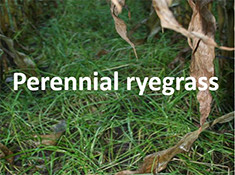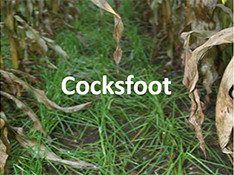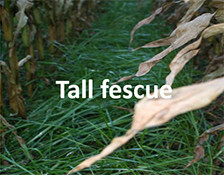Catch crops give maize growers numerous benefits
Growing a catch crop of grass within a field of maize offers farmers several benefits, such as retaining more nitrogen for the following crop, improving soil structure, and reducing erosion. And at the same time, a catch crop has a potential source of compliance with EU greening rules. And if they choose the right grass species, they can do all this with no loss of maize yield.
20/03/2017
Grass creates a potential environmental focus area
Under EU greening rules, any farm that's larger than 15 hectares has to include an environmental focus area (EFA) – an area that is good for the environment.
The rules vary from state to state, but one common method of creating an EFA is to grow a catch crop – a crop that is planted between the rows of a main crop. For example, grass grown between rows of maize is a catch crop.
The right grass for a field of maize
The challenge for maize growers has always been to find a catch crop that thrive on the low levels of light beneath the maize foliage without reducing the maize yield.
At DLF we have been working on finding the right species to meet this challenge, and now, after several successful trials, our researchers have identified three grass species that grow well in those gloomy conditions yet have no effect on the maize yield. They are: perennial ryegrass, cocksfoot, and tall fescue.
Timing is everything
Early in our research, we discovered that timing is essential for catch-crop success with maize. As well as finding those three soil-improving grass species, we were able to say when they should be sown for the best results.
To achieve the best performance, you have a choice of two sowing opportunities:
- At the time of your second weed control, typically when your maize has 3 to 4 leaves
- At the time of your third weed control, when your maize has 7 to 8 leaves
Our researchers also discovered that you should not sow too early. An early-sown catch crop restricts maize development and limits your ability to use chemical weed control.
Sowing method affects results
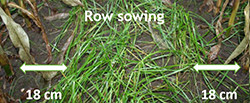 Our trials also revealed that catch crops establish better – and limit competition for nutrients – when sown at a distance of 18 to 20 cm from the maize rows. For the best germination, use row seeding to place the seed directly in the soil.
Our trials also revealed that catch crops establish better – and limit competition for nutrients – when sown at a distance of 18 to 20 cm from the maize rows. For the best germination, use row seeding to place the seed directly in the soil.
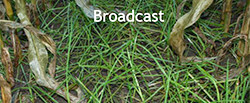 Broadcast sowing also works when followed by a light harrow or row tiller. But broadcasting without any follow-up reduces germination rates because the seeds rest on the soil surface.
Broadcast sowing also works when followed by a light harrow or row tiller. But broadcasting without any follow-up reduces germination rates because the seeds rest on the soil surface.
Maize yields unaffected by catch crops
During three years of testing we measured no significant loss of dry matter in the trial maize crops. This successful result appears to be independent of timing because we established our catch crop during both the early (3 to 4 leaves) and late (7 to 8 leaves) growth stages.
We also saw a significant level of nitrogen retention when we introduced the catch crop. Nitrogen performance varied, however, according to the stage of establishment. Early-stage establishment produced a higher level of nitrogen retention.
Other advantages of grass grown as a catch crop under maize
- Reduces soil loss on sloping fields (up to 800 to 1000 kg/ha on slopes)
- Improves soil structure
- Supports normal weed control
- Enhances the environmental profile of maize
More nitrogen in your fields and greening subsidies in your bank
Catch crops are good for your farm business, twice over. They help you comply with EU greening rules, and they help you hold on to your nitrogen. They improve farm performance without reducing your maize yields.
Read more about our grass-and-maize field trials or ask your local DLF representative for advice on using grass to help maintain soil fertility in your maize fields. They can suggest grasses that are proven to do good when sown with maize.


